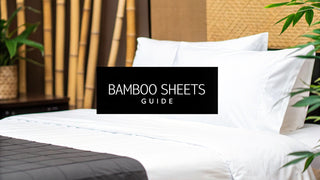Ever wondered if your bedding could actually improve your sleep? Imagine sliding into sheets so soft they feel like silk, yet so breathable they keep you perfectly cool all night. That's the real-world promise behind sheets bamboo, and it’s why so many people are making the switch from traditional cotton for a noticeable upgrade in comfort.
Why Are Bamboo Sheets a Smart Choice?
The buzz around bamboo sheets isn't just a trend; it's a solution to common sleep problems like overheating, skin irritation, and the desire for more sustainable products. For many, switching to sheets bamboo is an investment in better rest. In fact, bamboo fabric is known to be more absorbent than cotton, a key reason it excels at keeping you cool and dry. You can discover more insights about Australia's bamboo products market to see the trend for yourself.
The appeal boils down to three core benefits that deliver immediate value.
This infographic neatly sums up the three main reasons bamboo sheets stand out from the crowd.
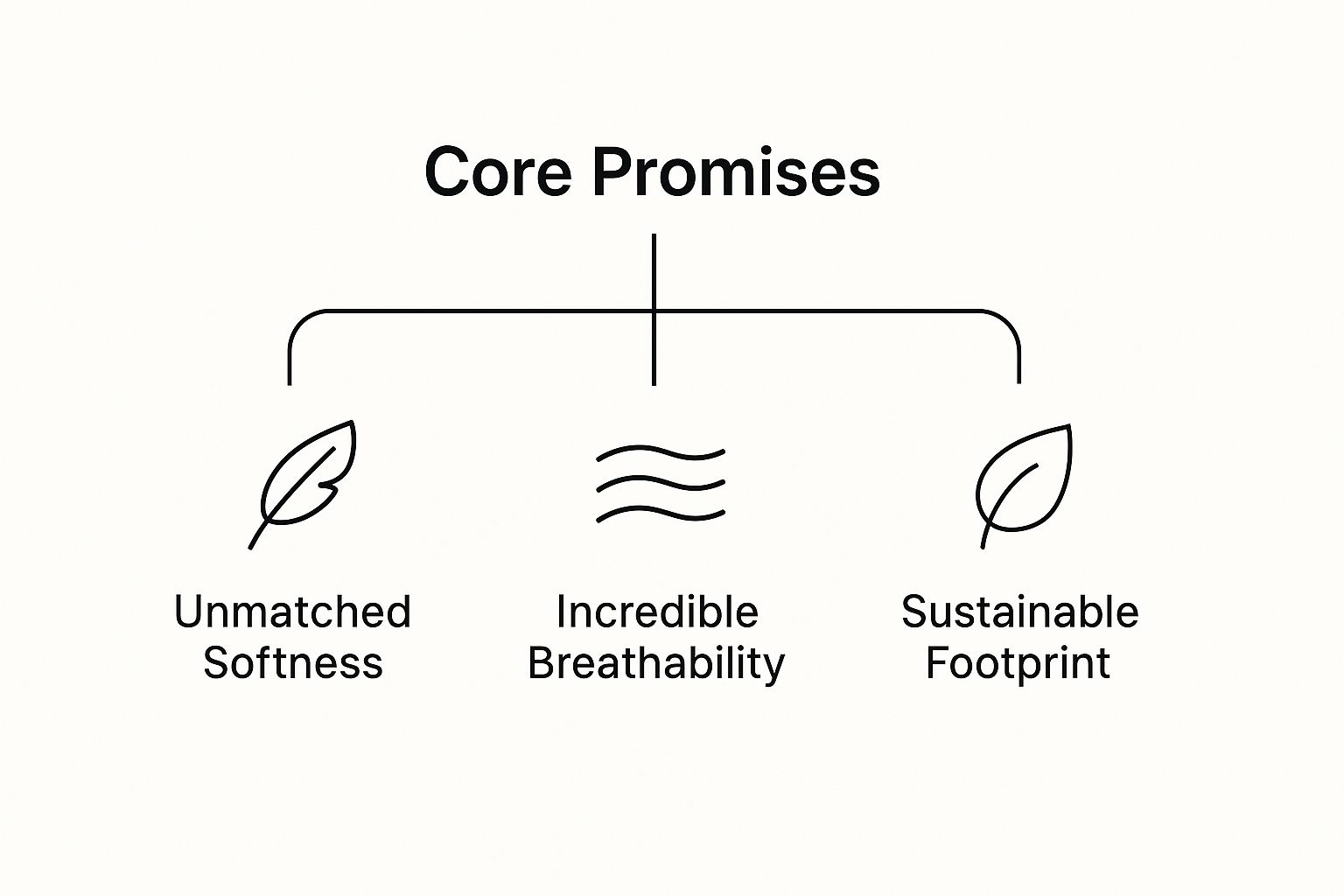
As you can see, the benefits all circle back to amazing comfort, better breathability, and a much friendlier eco-profile, which makes for a pretty compelling package.
Unmatched Softness for Luxurious Comfort
The first thing you'll notice about bamboo sheets is their incredible softness. The texture is often compared to a blend of silk and cashmere, giving it a smooth, gentle feel against your skin. Unlike cotton sheets that often need several washes to soften, bamboo is luxuriously soft right out of the package.
This natural softness is a game-changer for people with sensitive skin. For example, someone with eczema might find that the smooth fibres of bamboo sheets reduce friction and irritation during the night, leading to a more restful sleep. If you're exploring eco-friendly bedding materials, bamboo's comfort is a huge advantage.
Incredible Breathability for a Cooler Sleep
For hot sleepers or anyone living in a warm climate, bamboo’s breathability is a lifesaver. The fabric is naturally thermoregulating, meaning it adjusts to your body temperature to keep you comfortable.
Bamboo fibres are filled with micro-gaps, which provides ventilation and moisture absorption. This unique structure is what allows the fabric to keep you cool in summer and comfortably warm in winter, preventing that sweaty, tangled feeling you get with less breathable materials.
A real-world example is a couple where one person sleeps hot and the other sleeps cold. Bamboo sheets can help create a balanced sleeping environment, wicking away moisture from the hot sleeper while providing gentle insulation for the cold sleeper.
A More Sustainable Footprint
Finally, the environmental angle is a huge reason people are making the switch. As a raw material, bamboo is a sustainability champion. It's one of the fastest-growing plants on earth and requires significantly less water than traditional cotton. Plus, it grows rapidly without the need for pesticides or chemical fertilisers.
Choosing bamboo sheets is a practical step towards a more eco-conscious lifestyle. You get incredible comfort while supporting a more responsible textile industry.
Getting to Know the Different Bamboo Fabrics
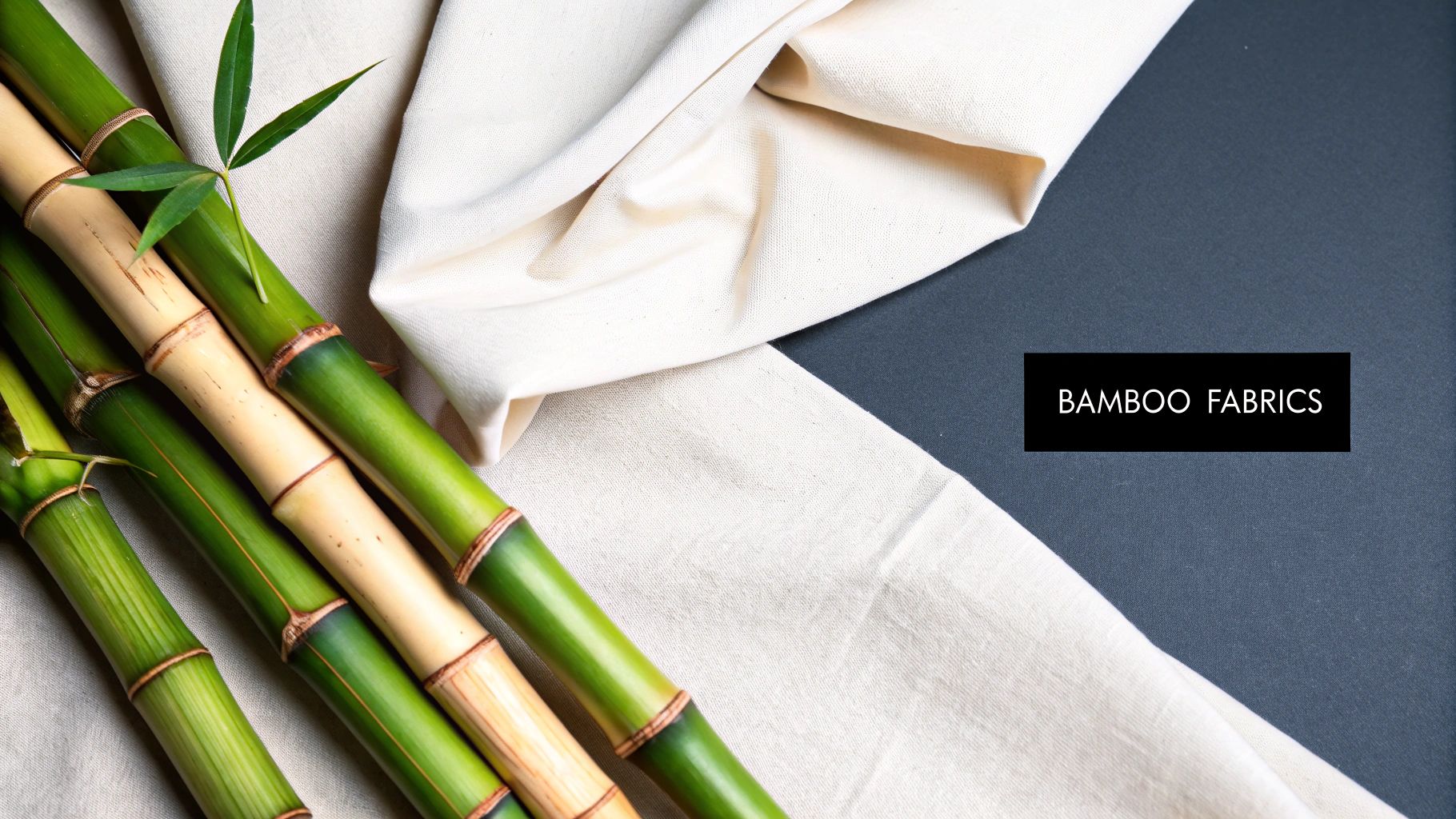
When you start shopping for sheets bamboo, you'll notice different fabric types. The method used to transform bamboo stalks into soft fabric changes its feel, durability, and environmental impact. Understanding these differences helps you choose the perfect set.
You'll mainly come across three types: Bamboo Viscose, Bamboo Lyocell, and Bamboo Modal. Each has its own unique character, so let’s get into what sets them apart.
Bamboo Viscose: The Popular Original
Bamboo Viscose, also called bamboo rayon, is the most common and affordable type. The process uses chemical solvents to dissolve bamboo pulp, which is then spun into soft fibres.
While this process delivers that signature silky softness, the traditional method can be harsh on the environment. However, many manufacturers are now adopting cleaner production techniques to minimise their impact.
The versatility of bamboo fibre is pretty impressive. It’s not just for bedding—its unique properties make it ideal for all sorts of products, including comfortable and practical bamboo fibre gloves, which really shows off its range.
Bamboo Lyocell: The Modern, Eco-Conscious Choice
Bamboo Lyocell is a huge leap forward in sustainable textile production. It’s considered the more premium and eco-friendly option because of its "closed-loop" manufacturing process.
This system uses a non-toxic solvent to break down the bamboo pulp. The best part? Over 99% of the solvent is captured, recycled, and reused. This minimises waste and creates a fabric that is incredibly strong, smooth, and breathable. If sustainability is a top priority, Lyocell is the clear winner.
Bamboo Fabric Comparison: Viscose vs Lyocell
This quick comparison table breaks down the main differences to help you decide what’s most important for your bedroom.
| Feature | Bamboo Viscose (Rayon) | Bamboo Lyocell |
|---|---|---|
| Feel | Incredibly soft and silky, but can be less durable over time. | Luxuriously soft and smooth with a very strong, resilient feel. |
| Process | Relies on chemical solvents in a traditional "open-loop" system. | Uses a non-toxic solvent in a modern "closed-loop" system. |
| Eco-Impact | Has a higher environmental impact due to chemical use and water consumption. | Has a much lower environmental impact, with significant solvent recycling. |
| Durability | Good, but can be susceptible to pilling without proper care. | Excellent durability and highly resistant to pilling and wear. |
| Cost | Generally more affordable and easier to find. | Tends to be more expensive due to the advanced manufacturing process. |
Ultimately, both fabrics feel amazing, but Lyocell offers a more durable and environmentally sound investment.
Bamboo Modal: The Extra-Soft Specialist
Bamboo Modal is a type of rayon that goes through an extra process to make the fibres even finer and softer. Modal is famous for its almost unbelievable softness and flexibility.
You won't often find sheets made from 100% bamboo modal. Instead, it’s usually blended with other materials like cotton to create a premium fabric for high-end clothing and bedding. It drapes beautifully and holds onto colour exceptionally well, meaning your sheets stay vibrant wash after wash.
What Are the Real Benefits of Sleeping on Bamboo?
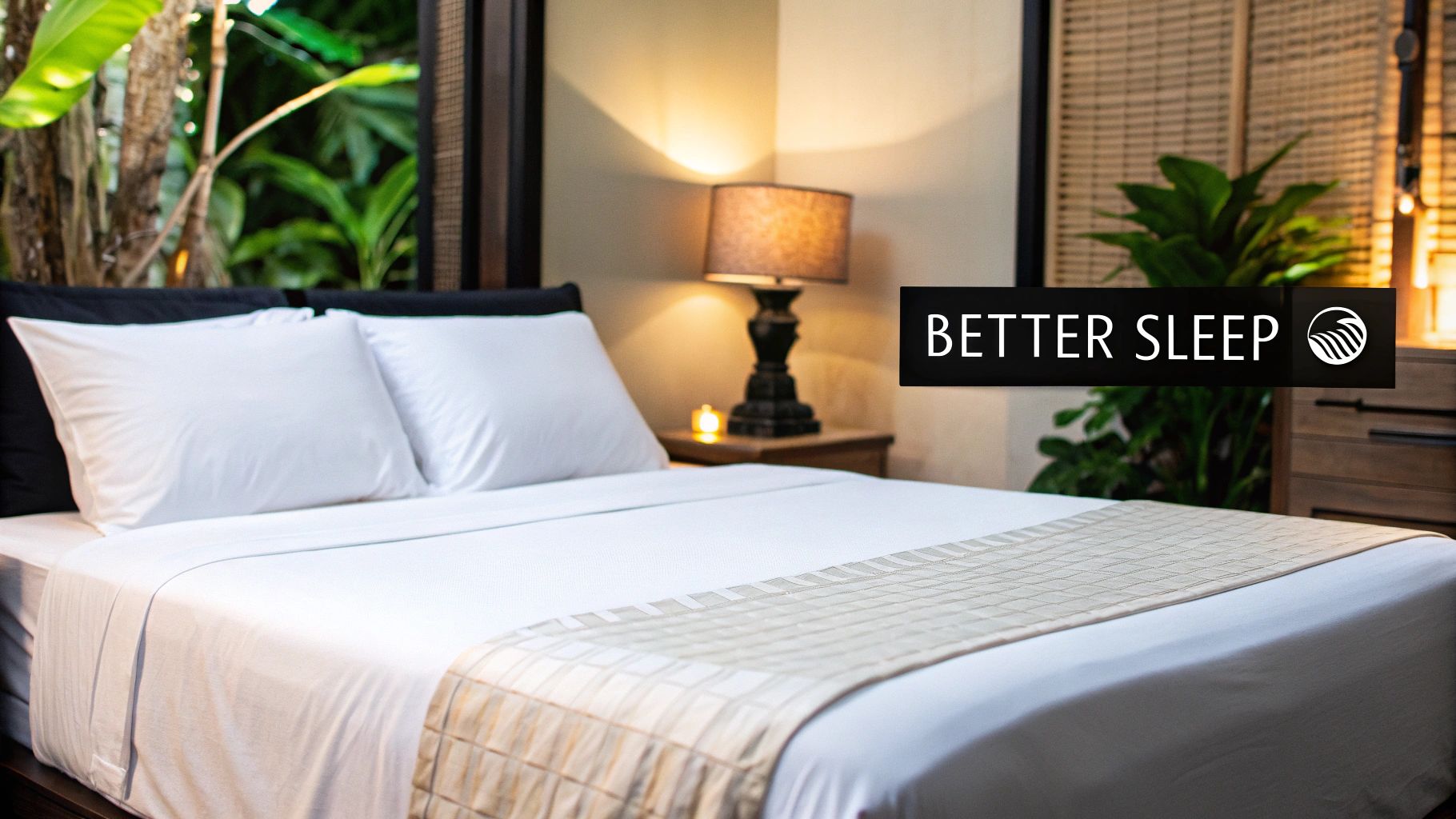
Beyond the marketing, what do bamboo sheets actually do for your sleep? It comes down to a few key benefits that tackle common problems like overheating and sensitive skin. These are genuine upgrades that can completely change how you rest.
The incredible softness is thanks to the long, smooth fibres of the bamboo plant. When woven, they create a fabric with far less friction than cotton. For anyone with sensitive skin, this is a game-changer, as the surface glides gently over your skin instead of rubbing against it.
An End to the Thermostat Wars
One of the most practical perks of bamboo sheets is their amazing ability to regulate temperature. If you’ve ever kicked off the covers while your partner shivers beside you, you know the nightly battle for the thermostat. Bamboo offers a natural truce.
The secret lies in the microscopic structure of the bamboo fibre, which is full of tiny pores that make it highly breathable.
Here’s how that helps in real life:
- For Hot Sleepers: The fibres are brilliant at absorbing moisture and wicking it away from your skin, where it can evaporate quickly. This process actively cools you down.
- For Cold Sleepers: The same breathable design traps a thin layer of warm air next to your body, giving you insulation without making you overheat.
This dual-action performance helps create a balanced microclimate in your bed. If you want to get into the science of it, you can learn more about what makes bamboo sheets so effective at wicking away moisture and keeping you dry.
A study on textile properties found that bamboo fabric's moisture absorption capacity is significantly higher than that of cotton. This exceptional absorbency is a key reason bamboo sheets are so effective at keeping sleepers cool and dry throughout the night.
A Healthier Sleep Environment
Beyond comfort, bamboo sheets help create a cleaner bed. The bamboo plant naturally contains an agent called "bamboo kun," which has antibacterial and antimicrobial properties. These qualities carry over to the finished fabric, helping your bedding stay fresher for longer.
This means the sheets naturally resist the growth of odour-causing bacteria.
This resistance also makes them hypoallergenic. They actively repel common allergens like dust mites. For anyone with allergies or asthma, this creates a more hygienic place to sleep, cutting down on sniffles and sneezes so you can breathe easier.
Are Bamboo Sheets a Truly Green Choice?
The "eco-friendly" tag is a huge drawcard for bamboo sheets, but the full picture depends on how the bamboo is transformed into fabric.
As a plant, bamboo is an environmental champion. It's a type of grass that grows incredibly fast, often several centimetres in a single day. This means it can be harvested frequently without harming the source. It also uses less water than thirsty cotton and thrives without pesticides.
The Manufacturing Story: The Part That Matters Most
Things get more complicated when we move from the field to the factory. The method used to turn bamboo into bedding is the most critical factor in its overall environmental footprint.
- The Viscose Process: This common method uses chemical solvents to break down bamboo pulp. Traditional viscose manufacturing can release harmful chemicals if not managed carefully.
- The Lyocell Process: This is the modern, greener alternative. It uses a non-toxic solvent in a "closed-loop" system, meaning over 99% of the solvent and water is captured and reused. It drastically cuts down on waste, making it the most sustainable choice.
For Australian shoppers, who are increasingly looking for green products, understanding this distinction is key. You can learn more about Australian consumer trends towards bamboo to see why this matters so much.
How to Spot a Genuinely Green Product
So, how can you be sure you’re buying sustainable sheets? Look for independent, third-party certifications on the label.
Think of these certifications as a trusted umpire's call. They verify that the product meets strict global standards for safety and sustainability, giving you confidence that you're making a responsible choice.
Keep an eye out for these two key certifications:
- OEKO-TEX Standard 100: This label guarantees that every component has been tested for harmful substances and is safe for human health.
- Forest Stewardship Council (FSC): This certification ensures the bamboo was sourced from a responsibly managed forest, protecting biodiversity and supporting local communities.
By choosing sheets made using the lyocell process and carrying both certifications, you can feel confident you’re investing in a genuinely kinder product. Our guide to the top eco-friendly bedding materials can help you see how it stacks up against other sustainable choices.
How to Choose Your Perfect Bamboo Sheet Set
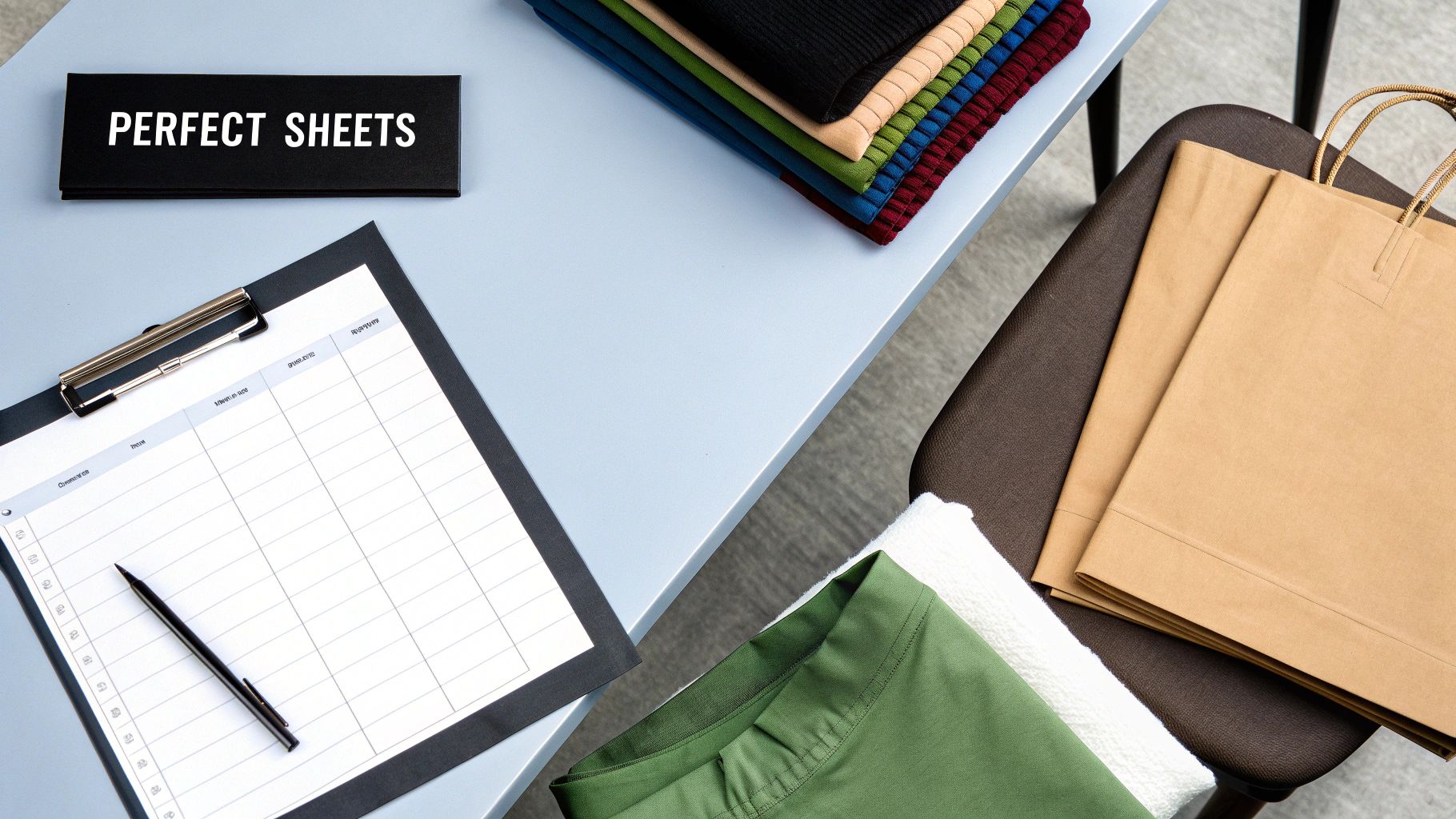
Ready to pick out the perfect set of bamboo sheets? Knowing what to look for is the key to making a great choice. This guide will walk you through the important stuff so you can find sheets you’ll love for years.
Sateen vs Twill: The Great Weave Debate
For bamboo sheets, you’ll mainly find two weave choices: sateen and twill. It really just boils down to your personal preference.
- Sateen Weave: If you dream of a silky, lustrous finish that drapes beautifully, sateen is your winner. It has a slightly heavier feel and a gorgeous sheen that looks luxurious.
- Twill Weave: Prefer something a bit crisper and more durable? Twill has a distinctive diagonal pattern that makes it incredibly strong and less prone to wrinkling.
Think about your current sheets. Do you love a sleek, smooth feel, or something with more structure? Your answer will point you in the right direction.
Why Thread Count Isn't the Whole Story
We’ve all been trained to look for a high thread count as a sign of quality. But with bamboo, that number is far less important. Bamboo fibres are naturally so long and fine that they create an exceptionally soft fabric, even with a lower thread count.
Instead of getting hung up on thread count, it's much better to focus on the quality of the bamboo itself (100% bamboo lyocell is a top-tier choice) and the weave. A well-made 300-thread-count bamboo sheet set will feel far more luxurious than a poorly made 1000-thread-count cotton one.
Focus on the tangible things that truly matter for incredible comfort.
Your Quality Checklist for Buying Bamboo Sheets
When you're ready to buy, keep this simple checklist handy.
- Check the Material: Look for sheets made from 100% bamboo. Ideally, you want bamboo lyocell for its superior feel and eco-friendly production. Blends with cotton or microfibre will reduce the unique benefits of bamboo.
- Look for Certifications: Certifications like OEKO-TEX and FSC are your assurance that the sheets are free from harmful chemicals and made with sustainably sourced bamboo.
- Read the Reviews: See what other people are saying. Pay attention to comments about how the sheets feel after a few washes, whether they pill, and how the colour holds up.
- Understand the Price: Be wary of prices that seem too good to be true. Premium bamboo lyocell sheets are an investment, and you should expect to pay a bit more than for standard cotton.
- Confirm the Return Policy: A company that believes in its product will stand behind it. Look for a generous trial period or a straightforward return policy for peace of mind.
By keeping these points in mind, you can shop with confidence. Our comprehensive guide to bed sheets has even more information to help you find the perfect bedding.
Caring For Your Sheets to Make Them Last
Keeping your beautifully soft bamboo sheets in top condition is easier than you might think. A few gentle habits will preserve the delicate fibres, ensuring every night feels as comfortable as the first.
The Golden Rules of Washing
Washing your sheets correctly is the most important step. The goal is to clean them effectively without causing damage or shrinkage.
Here are the essential steps:
- Wash in Cold Water: Always use a cold wash setting—no warmer than 30°C. Hot water can cause the delicate bamboo fibres to shrink and weaken.
- Use a Gentle Cycle: Select the most delicate cycle your machine offers. This minimises stress on the fabric.
- Choose a Mild Detergent: A gentle, pH-neutral liquid detergent is best. Avoid harsh detergents and stain removers.
A common mistake is using fabric softener or bleach. Fabric softeners can coat the fibres, reducing their moisture-wicking abilities. Bleach is too aggressive and can cause permanent damage to the bamboo material.
Drying Your Bamboo Sheets Properly
How you dry your sheets is just as important as how you wash them. High heat is the number one enemy.
Line drying is the best method. Hanging your sheets outside helps them last longer and leaves them smelling fresh. If you must use a dryer, select the lowest heat setting or an air-dry option.
For a more detailed walkthrough, our guide on how to wash bamboo sheets covers everything you need to know.
Still Wondering About Bamboo Sheets?
It's normal to have a few questions. We've put together answers to some of the most common ones so you can feel confident about making the switch.
Do Bamboo Sheets Wrinkle Easily?
Yes, genuine bamboo sheets will wrinkle a bit, just like high-quality cotton. This is a good sign! It means the fabric is made from natural fibres and hasn't been coated with harsh, anti-wrinkle chemicals.
The wrinkles are usually soft and subtle. The best trick is to pull them from the dryer while they're still slightly damp and put them straight on the bed. Their weight helps smooth them out.
Are Bamboo Sheets Really Worth the Price Tag?
While bamboo sheets often cost more upfront, they are a long-term investment. They are incredibly durable and can easily outlast several cheaper sets, saving you money in the long run.
You're also paying for features other materials can't deliver:
- Next-Level Comfort: The silky, smooth feel is in a class of its own.
- Smart Temperature Control: They genuinely help regulate your temperature.
- A Healthier Sleep: Being naturally hypoallergenic, they resist dust mites and allergens.
Most people find the dramatic improvement in their sleep quality makes it worth every cent.
How Do They Feel Compared to Egyptian Cotton?
This is a great question, and it really comes down to personal preference. Egyptian cotton is known for that classic, crisp hotel-sheet feeling.
Bamboo, however, feels silky and fluid from the start. It drapes over you in a way that feels almost weightless and incredibly smooth.
Here's an analogy: Egyptian cotton is like a perfectly tailored, crisp linen shirt—classic and cool. Bamboo is like a flowing silk blouse—fluid, soft, and elegant. If you crave a buttery, sleek feel and need excellent moisture-wicking, bamboo is probably your soulmate.
Should I Worry About Thread Count for Bamboo Sheets?
For bamboo, thread count isn’t the main event. Bamboo fibres are naturally so much longer and finer that a massive thread count isn't needed for a luxe feel. To learn more, check out our guide to finding the perfect bed sheets.
Most top-quality bamboo sheets have a thread count between 300-500. You'll get a much better sense of quality by looking at the fabric type (100% bamboo lyocell is the gold standard) and the weave.
Ready for a Better Night's Sleep?
Investing in quality bamboo sheets is an investment in your comfort, health, and well-being. From their unmatched softness to their smart temperature regulation, the benefits translate into a genuinely better night's sleep. Now that you're armed with all the information you need, you can choose the perfect set with confidence.
Ready to feel the difference for yourself? Discover your best night's sleep and explore our collection of premium bamboo bedding today at https://www.siennaliving.com.au.

